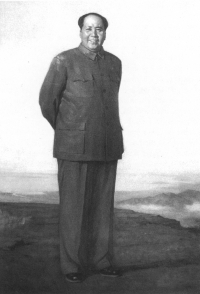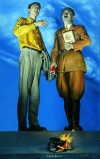
Illustration:
ill. 5.17 (set: 5.17)
Author:
Jin Shangyi (1938-) 靳尚谊
Date:
1966
Genre:
painting, oil painting
Material:
scan, paper, grayscale; original source: oil on canvas
Source:
Andrews 1994: Andrews, Julia. Painters and Politics in the People’s Republic of China, 1949-1979. Berkeley: University of California Press, 1994:431, fig.117.
Courtesy:
University of California Press Berkeley
Keywords:
Mao Zedong, Mao goes to Anyuan, Jin Shangyi, Liu Chunhua, mountains, clouds, European artistic heritage, European painting tradition, Chinese painting tradition, Chinese artistic heritage, Yan´an Talks
Jin Shangyi: Chairman Mao at Lushan (Jin Shangyi: Mao Zhuxi zai Lushan 靳尚谊:毛主席在庐山)
Structurally, Liu's and Jin's works are very similar in design: they both present Mao as an overpowering figure on top of a mountain with clouds and mountain peaks in the background echoing Mao’s movements. Yet, in the case of Jin, who depicts the older Mao in a Mao suit, the European model is much more obvious, his mountains are much less rugged, cone-shaped and sharp, they are much more flat, rolling and smooth and thus far less akin to the Chinese tradition of painting mountain ranges (ill. 5.18). By adding iconographic elements from Chinese landscape painting into an oil composition in the style of Revolutionary Realism and Revolutionary Romanticism, Liu, on the other hand, had created a perfect piece of national flavour, combining the best of European art (no matter from what period, any European art would be considered “contemporary” or “modern” in China, see Mittler 1997) with the best of China’s traditions—just as Mao had demanded in his Yan’an Talks.












































































































